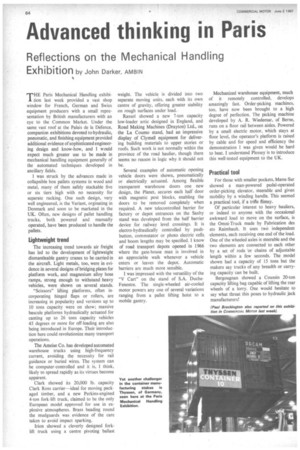Advanced thinking in Paris
Page 66

If you've noticed an error in this article please click here to report it so we can fix it.
Reflections on the Mechanical Handling
Exhibition by John Darker, AMBIN THE Paris Mechanical Handling exhibition last week provided a vast shop window for French, German and Swiss equipment producers with a small representation by British manufacturers with an eye to the Common Market. Under the same vast roof at the Palais de la Defence, companion exhibitions devoted to hydraulic, pneumatic, and finishing equipment provided additional evidence of sophisticated engineering design and know-how, and I would expect much greater use to be made in mechanical handling equipment generally of the automated techniques developed in ancillary fields.
I was struck by the advances made in collapsible box pallets systems in wood and metal, many of them safely stackable five or six tiers high with no necessity for separate racking. One such design, very well engineered, is the Variant, orginating in Denmark and soon to be marketed in the UK. Often, new designs of pallet handling trucks, both powered and manually operated, have been produced to handle the pallets.
Lightweight trend
The increasing trend towards air freight has led to the development of lightweight dismantleable gantry cranes to be carried in the aircraft. Light metals, too, were in evidence in several designs of bridging plates for platform work, and magnesium alloy hose ramps, strong enough to withstand heavy vehicles, were shown on several stands.
"Scissors" lifting platforms, often incorporating hinged flaps or rollers, are increasing in popularity and versions up to 10 tons capacity were on show; massive bascule platforms hydraulically actuated for canting up to 26 tons capacity vehicles 45 degrees or more for off-loading are also being introduced in Europe. Their introduction here could revolutionize many transport operations.
The Ameise Co. has developed automated warehouse trucks using high-frequency current, avoiding the necessity for rail guidance or buried wires. The system can be computer-controlled and it is, I think, likely to spread rapidly as its virtues become apparent.
Clark showed its 20,000 lb. capacity Clark Ross carrier—ideal for moving packaged timber, and a new Perkins-engined 4-ton fork-lift truck, claimed to be the only European model approved for use in explosive atmospheres. Brass beading round the mudguards was evidence of the care taken to avoid impact sparking.
Irion showed a cleverly designed forklift truck using a centre pivoting ballast weight. The vehicle is divided into two separate moving units, each with its own centre of gravity, offering greater stability on rough surfaces under load.
Rassol showed a new 7-ton capacity low-loader artic designed in England, and Road Making Machines (Drayton) Ltd., on the La Coumo stand, had an impressive display of Clymall equipment for delivering building materials to upper stories or roofs. Such work is not normally within the province of the road haulier, though there seems no reason in logic why it should not be.
Several examples of automatic opening vehicle doors were shown, pneumatically or electrically actuated. Among flexible transparent warehouse doors one new design, the Planet, secures each half door with magnetic post blocks, enabling the doors to be removed completely when required. A new telecontrolled barrier for factory or depot entrances on the Saxby stand was developed from the half barrier device for railway level crossings. It is electro-hydraulically controlled by pushbutton, commutator or photo electric cells and boom lengths may be specified. 1 know of road transport depots opened in 1966 where the gate-house man is involved in an appreciable walk whenever a vehicle enters or leaves the depot. Automatic barriers are much more sensible.
I was impressed with the versatility of the "V Cart" on the stand of S.A. DuetteFenestre. The single-wheeled air-cooled motor powers any one of several variations ranging from a pallet lifting hoist to a mobile gantry. Mechanized warehouse equipment, much of it remotely controlled, develops amazingly fast. Order-picking machines, too, have now been brought to a high degree of perfection. The picking machine developed by A. R. Wiedemar, of Berne, runs on a floor rail between aisles. Powered by a small electric motor, which stays at floor level, the operator's platform is raised by cable and for speed and efficiency the demonstration I was given would be hard to beat. I understand Plessey is to introduce this well-tested equipment to the UK.
Practical tool
For those with smaller pockets, Manu-Sur showed a man-powered pedal-operated order-picking elevator, steerable and given mobility by a winding handle. This seemed a practical tool, if a trifle flimsy.
Of particular interest to heavy hauliers, or indeed to anyone with the occasional awkward load to move on the surface, is the Omni-Truck made by Fabrication des ets Raimbault. It uses two independent -elements, each receiving one end of the load. One of the wheeled axles is steerable and the two elements are connected to each other by a set of rods or chains of adjustable length within a few seconds. The model shown had a capacity of 15 tons but the makers say trucks of any breadth or carrying capacity can be built.
Bergougnan showed a Coussin 20-ton capacity lifting bag capable of lifting the rear wheels of a lorry. One would hesitate to say what threat this poses to hydraulic jack manufacturers!




























































































































































